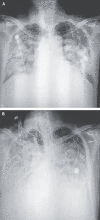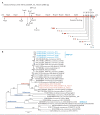A Novel Coronavirus from Patients with Pneumonia in China, 2019 - PubMed (original) (raw)
. 2020 Feb 20;382(8):727-733.
doi: 10.1056/NEJMoa2001017. Epub 2020 Jan 24.
Dingyu Zhang 1, Wenling Wang 1, Xingwang Li 1, Bo Yang 1, Jingdong Song 1, Xiang Zhao 1, Baoying Huang 1, Weifeng Shi 1, Roujian Lu 1, Peihua Niu 1, Faxian Zhan 1, Xuejun Ma 1, Dayan Wang 1, Wenbo Xu 1, Guizhen Wu 1, George F Gao 1, Wenjie Tan 1; China Novel Coronavirus Investigating and Research Team
Affiliations
- PMID: 31978945
- PMCID: PMC7092803
- DOI: 10.1056/NEJMoa2001017
A Novel Coronavirus from Patients with Pneumonia in China, 2019
Na Zhu et al. N Engl J Med. 2020.
Abstract
In December 2019, a cluster of patients with pneumonia of unknown cause was linked to a seafood wholesale market in Wuhan, China. A previously unknown betacoronavirus was discovered through the use of unbiased sequencing in samples from patients with pneumonia. Human airway epithelial cells were used to isolate a novel coronavirus, named 2019-nCoV, which formed a clade within the subgenus sarbecovirus, Orthocoronavirinae subfamily. Different from both MERS-CoV and SARS-CoV, 2019-nCoV is the seventh member of the family of coronaviruses that infect humans. Enhanced surveillance and further investigation are ongoing. (Funded by the National Key Research and Development Program of China and the National Major Project for Control and Prevention of Infectious Disease in China.).
Copyright © 2020 Massachusetts Medical Society.
Figures
Figure 1. Chest Radiographs.
Shown are chest radiographs from Patient 2 on days 8 and 11 after the onset of illness. The trachea was intubated and mechanical ventilation instituted in the period between the acquisition of the two images. Bilateral fluffy opacities are present in both images but are increased in density, profusion, and confluence in the second image; these changes are most marked in the lower lung fields. Changes consistent with the accumulation of pleural liquid are also visible in the second image.
Figure 2. Cytopathic Effects in Human Airway Epithelial Cell Cultures after Inoculation with 2019-nCoV.
Figure 3. Visualization of 2019-nCoV with Transmission Electron Microscopy.
Negative-stained 2019-nCoV particles are shown in Panel A, and 2019-nCoV particles in the human airway epithelial cell ultrathin sections are shown in Panel B. Arrowheads indicate extracellular virus particles, arrows indicate inclusion bodies formed by virus components, and triangles indicate cilia.
Figure 4. Schematic of 2019-nCoV and Phylogenetic Analysis of 2019-nCoV and Other Betacoronavirus Genomes.
Shown are a schematic of 2019-nCoV (Panel A) and full-length phylogenetic analysis of 2019-nCoV and other betacoronavirus genomes in the Orthocoronavirinae subfamily (Panel B).
Comment in
- Another Decade, Another Coronavirus.
Perlman S. Perlman S. N Engl J Med. 2020 Feb 20;382(8):760-762. doi: 10.1056/NEJMe2001126. Epub 2020 Jan 24. N Engl J Med. 2020. PMID: 31978944 Free PMC article. No abstract available. - What to do next to control the 2019-nCoV epidemic?
Wang FS, Zhang C. Wang FS, et al. Lancet. 2020 Feb 8;395(10222):391-393. doi: 10.1016/S0140-6736(20)30300-7. Lancet. 2020. PMID: 32035533 Free PMC article. No abstract available. - The course of clinical diagnosis and treatment of a case infected with coronavirus disease 2019.
Han W, Quan B, Guo Y, Zhang J, Lu Y, Feng G, Wu Q, Fang F, Cheng L, Jiao N, Li X, Chen Q. Han W, et al. J Med Virol. 2020 May;92(5):461-463. doi: 10.1002/jmv.25711. Epub 2020 Mar 1. J Med Virol. 2020. PMID: 32073161 Free PMC article. No abstract available. - Fear of the novel coronavirus.
Kelvin DJ, Rubino S. Kelvin DJ, et al. J Infect Dev Ctries. 2020 Jan 31;14(1):1-2. doi: 10.3855/jidc.12496. J Infect Dev Ctries. 2020. PMID: 32088678 No abstract available. - Diabetes and COVID-19.
Bloomgarden ZT. Bloomgarden ZT. J Diabetes. 2020 Apr;12(4):347-348. doi: 10.1111/1753-0407.13027. J Diabetes. 2020. PMID: 32162476 No abstract available. - The COVID-19 pandemic: New global challenges for the haemophilia community.
Hermans C, Weill A, Pierce GF. Hermans C, et al. Haemophilia. 2020 May;26(3):371-372. doi: 10.1111/hae.14001. Epub 2020 Apr 20. Haemophilia. 2020. PMID: 32246879 No abstract available. - Practice of novel method of bedside postpyloric tube placement in patients with coronavirus disease 2019.
Yuan ST, Zhang WH, Zou L, Sun JK, Liu Y, Shi QK. Yuan ST, et al. Crit Care. 2020 Apr 7;24(1):135. doi: 10.1186/s13054-020-02863-0. Crit Care. 2020. PMID: 32264974 Free PMC article. No abstract available. - [SARS-CoV-2 and the scientific community].
Di Pasquale G. Di Pasquale G. G Ital Cardiol (Rome). 2020 May;21(5):317-320. doi: 10.1714/3343.33126. G Ital Cardiol (Rome). 2020. PMID: 32310914 Italian. No abstract available. - Neurology in the time of COVID-19.
Manji H, Carr AS, Brownlee WJ, Lunn MP. Manji H, et al. J Neurol Neurosurg Psychiatry. 2020 Jun;91(6):568-570. doi: 10.1136/jnnp-2020-323414. Epub 2020 Apr 20. J Neurol Neurosurg Psychiatry. 2020. PMID: 32312872 No abstract available. - Pulmonary thromboembolism in critical ill COVID-19 patients.
Scialpi M, Scialpi S, Piscioli I, Battista Scalera G, Longo F. Scialpi M, et al. Int J Infect Dis. 2020 Jun;95:361-362. doi: 10.1016/j.ijid.2020.04.056. Epub 2020 Apr 24. Int J Infect Dis. 2020. PMID: 32339717 Free PMC article. - Descriptive study of COVID-19 outbreak among passengers and crew on Diamond Princess cruise ship, Yokohama Port, Japan, 20 January to 9 February 2020.
Yamagishi T, Kamiya H, Kakimoto K, Suzuki M, Wakita T. Yamagishi T, et al. Euro Surveill. 2020 Jun;25(23):2000272. doi: 10.2807/1560-7917.ES.2020.25.23.2000272. Euro Surveill. 2020. PMID: 32553062 Free PMC article. - Could there be a link between oral hygiene and the severity of SARS-CoV-2 infections?
Sampson V, Kamona N, Sampson A. Sampson V, et al. Br Dent J. 2020 Jun;228(12):971-975. doi: 10.1038/s41415-020-1747-8. Br Dent J. 2020. PMID: 32591714 Free PMC article. - [COVID-19-never waste a crisis?!].
Herold CJ, Delorme S, Weber MA, Reith W, Helmberger T, Reiser M. Herold CJ, et al. Radiologe. 2020 Oct;60(10):891-892. doi: 10.1007/s00117-020-00750-x. Radiologe. 2020. PMID: 32995967 Free PMC article. German. No abstract available.
Similar articles
- Genomic characterisation and epidemiology of 2019 novel coronavirus: implications for virus origins and receptor binding.
Lu R, Zhao X, Li J, Niu P, Yang B, Wu H, Wang W, Song H, Huang B, Zhu N, Bi Y, Ma X, Zhan F, Wang L, Hu T, Zhou H, Hu Z, Zhou W, Zhao L, Chen J, Meng Y, Wang J, Lin Y, Yuan J, Xie Z, Ma J, Liu WJ, Wang D, Xu W, Holmes EC, Gao GF, Wu G, Chen W, Shi W, Tan W. Lu R, et al. Lancet. 2020 Feb 22;395(10224):565-574. doi: 10.1016/S0140-6736(20)30251-8. Epub 2020 Jan 30. Lancet. 2020. PMID: 32007145 Free PMC article. - A new coronavirus associated with human respiratory disease in China.
Wu F, Zhao S, Yu B, Chen YM, Wang W, Song ZG, Hu Y, Tao ZW, Tian JH, Pei YY, Yuan ML, Zhang YL, Dai FH, Liu Y, Wang QM, Zheng JJ, Xu L, Holmes EC, Zhang YZ. Wu F, et al. Nature. 2020 Mar;579(7798):265-269. doi: 10.1038/s41586-020-2008-3. Epub 2020 Feb 3. Nature. 2020. PMID: 32015508 Free PMC article. - Genomic characterization of the 2019 novel human-pathogenic coronavirus isolated from a patient with atypical pneumonia after visiting Wuhan.
Chan JF, Kok KH, Zhu Z, Chu H, To KK, Yuan S, Yuen KY. Chan JF, et al. Emerg Microbes Infect. 2020 Jan 28;9(1):221-236. doi: 10.1080/22221751.2020.1719902. eCollection 2020. Emerg Microbes Infect. 2020. PMID: 31987001 Free PMC article. - [Etiology of epidemic outbreaks COVID-19 on Wuhan, Hubei province, Chinese People Republic associated with 2019-nCoV (Nidovirales, Coronaviridae, Coronavirinae, Betacoronavirus, Subgenus Sarbecovirus): lessons of SARS-CoV outbreak.].
Lvov DK, Alkhovsky SV, Kolobukhina LV, Burtseva EI. Lvov DK, et al. Vopr Virusol. 2020;65(1):6-15. doi: 10.36233/0507-4088-2020-65-1-6-15. Vopr Virusol. 2020. PMID: 32496715 Review. Russian.
Cited by
- Research progress on environmental stability of SARS-CoV-2 and influenza viruses.
Zhang L, Fang Z, Li J, Huang Z, Tie X, Li H, Li J, Zhang Y, Zhang Y, Chen K. Zhang L, et al. Front Microbiol. 2024 Oct 31;15:1463056. doi: 10.3389/fmicb.2024.1463056. eCollection 2024. Front Microbiol. 2024. PMID: 39545235 Free PMC article. Review. - [Morbidity and mortality in hospitalised patients vaccinated versus hospitalised patients not vaccinated against COVID-19 in three regions of Cameroon].
Bevela JY, Billong S, Njankouo YM, Kenko I, Bonsou G. Bevela JY, et al. Pan Afr Med J. 2024 Jul 18;48:114. doi: 10.11604/pamj.2024.48.114.40348. eCollection 2024. Pan Afr Med J. 2024. PMID: 39545032 Free PMC article. French. - Seroprevalence and silent infection rate during SARS-CoV-2 pandemic among children and adolescents in Western Pomerania: a multicenter, cross-sectional study-the COVIDKID study.
Vollmer M, Kuthning D, Gramenz J, Scholz A, Michael R, Wittmann N, Gesser U, Niesytto C, Vogler A, Tuxhorn V, Lenschow U, Lange A, Linnemann K, Lode H, Kaderali L, Meyer-Bahlburg A. Vollmer M, et al. PeerJ. 2024 Nov 11;12:e18384. doi: 10.7717/peerj.18384. eCollection 2024. PeerJ. 2024. PMID: 39544417 Free PMC article. - Assessment of COVID-19 severity levels and associated factors among patients admitted to the treatment centers in Southern Ethiopia.
Tirore LL, Sergindo MT, Areba AS, Hailegebireal AH, Desalegn M. Tirore LL, et al. Front Med (Lausanne). 2024 Oct 31;11:1403615. doi: 10.3389/fmed.2024.1403615. eCollection 2024. Front Med (Lausanne). 2024. PMID: 39544381 Free PMC article. - Brain-wide alterations revealed by spatial transcriptomics and proteomics in COVID-19 infection.
Zhang T, Li Y, Pan L, Sha J, Bailey M, Faure-Kumar E, Williams CK, Wohlschlegel J, Magaki S, Niu C, Lee Y, Su YC, Li X, Vinters HV, Geschwind DH. Zhang T, et al. Nat Aging. 2024 Nov;4(11):1598-1618. doi: 10.1038/s43587-024-00730-z. Epub 2024 Nov 14. Nat Aging. 2024. PMID: 39543407
References
- Masters PS, Perlman S. Coronaviridae. In: Knipe DM, Howley PM, eds. Fields virology. 6th ed. Lippincott Williams & Wilkins, 2013:825-58.
MeSH terms
LinkOut - more resources
Full Text Sources
Other Literature Sources
Miscellaneous



